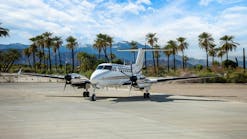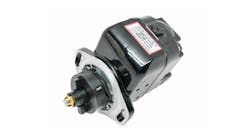By John Boyce, Contributing Editor
Refueler manufacturers are as puzzled as FBOs, airports, and other interested parties by the EPA's apparent insistence that fuel delivery vehicles are storage containers when stationary and require secondary spill containment. And they can't offer a practical, technological solution. Meanwhile, the OEMs are moving ahead with other technological advances.
Steven Paul, president of Garsite, a tank and refueler manufacturer in Kansas City, understands that the rule (40 CFR 112.7e2xi) is in the 1974 legislation pertaining to Spill Prevention, Control, and Countermeasures. But he is at a loss to explain why a refueler would be more vulnerable when stationary than when in motion.
"The most likely release (of fuel) will take place when the refueler is in motion," Paul says. "It can sheer off a valve or drive off with the hose still attached. And I can’t recall any problems except perhaps an overturned truck or something like that."
One of Paul’s customers, in fact, checked EPA spill records and couldn’t find an instance when there was a release from a parked fuel truck."I don’t know of anything that can be done (to provide the containment)," Paul says. "We were asked if we could build an item that a truck could drive onto while getting fuel or when it was parked. But then we understood that we had to do that underneath the airplane" and that wasn’t feasible.
Terry Bosserman, president of Bosserman Aviation Equipment in Carey, OH, doesn’t rule out the possibility of OEMs coming up with a solution but he, like his fellow manufacturers, is concerned about the cost.
"We have actually built trucks for Air BP that had environmental safety pans under the truck," Bosserman says. "If anything leaked on that truck the pans would retain it. It would not retain the total amount of the truck but if a flange leaked, a pump leaked, whatever, it would be retained on the truck. So to say it’s impossible, it’s not ... The only problem with these environmental pans is when it rains or snows you also have to deal with the rain, the snow, and the ice."
If EPA was to mandate a device or method, Bosserman sees that it could be good for him personally "because that’s more stuff we can sell, but from an industry standpoint it’s going to hurt because anytime we put more cost on the industry it just puts more burden on it... If it’s a safety issue I’m all for it, but if they look at the overall amount of product that is spilled from our industry it is going to be very small compared to other industries."
If a refueler does leak, says Mike Wilkinson, President of Rampmaster in Coatesville, PA, it is easily seen and dealt with. "If you have a mobile refueler," Wilkinson says, "and a leak is identified, unlike a storage tank that is not mobile, you can drive this over to a containment area, notably your fuel farm ... and you can eliminate the problem. You can’t do that with a fixed asset; you can with a mobile refueler. So why the EPA is focused on this when they already have countermeasures available is beyond me."
If pressed for a solution, Wilkinson says, "The only thing you can do: Grandfather all existing refuelers and require that all tanks be double-walled. Then you could put a containment area between the inner and outer tank and if you sampled the outer tank through a drain port and you found any trace of jet fuel you would know you have a leak."
INCORPORATING TECHNOLOGIES
While refueler manufacturers have not settled on a way to resolve the containment issue, they have been busy incorporating technologies into refuelers to make them safer, more efficient, and more environmentally friendly. Among the most noteworthy developments is the construction by Bosserman of an electric-driven refueler, albeit, a small (750 gallons) truck that dispenses avgas.
"It’s been a big push," Bosserman says, "to get fossil fuel engines out of there to reduce maintenance cost and reduce emissions ... We’ve got trucks out there right now, in both a refueler and hydrant servicer that have no fossil fuel engine on them whatsoever.
"It’s a 96-volt system that drives everything. Basically, it takes a 55-horsepower, 96-volt system and that motor sits in the same motor mounts where the diesel engine sits. Basically, we buy an Isuzu chassis, pull the diesel engine and the radiator, and put this 55-horsepower motor back in it, and the electronic controller sits in the frame where the radio used to be. We use all the other components from Isuzu – the transmission, the braking system, the rear end, driveshaft, running gear."
While that’s a long way from an electric-driven jet fueler, Bosserman has been asked by a customer to build an electric unit that will carry 2,000 gallons of avgas. He and his chassis supplier are currently working on "piggybacking" two 55-horsepower motors to handle the larger unit.
Because of concerns about using air pressure during fueling operations in cold weather, refuelers have been using the fuel pressure. Air systems can freeze up in cold weather. "We are now driving a lot of the components with fuel pressure versus air pressure," Bosserman says. "That’s the latest thing to make the truck more reliable, especially in cold climates."
Scott Thomas at Determan Brownie and Steven Paul at Garsite report that they are using alternative power on hydrant carts. Determan Brownie’s system applies a hydraulic system while Garsite uses solar power.
"We have developed a cart that uses no electricity or no air," Thomas says. "It’s extremely low maintenance; you don’t have to maintain the electrical system, you don’t have to maintain an air system. And there are no batteries, no recharging. It will operate on the ramp up to 35 degrees below zero ..."
Thomas also reports that his company has developed a cart control center. "It takes all the controls off the cart and puts them in one simple location. All the adjustments are done at one location [with] a field box that prevents tampering."
Paul acknowledges that a solar-powered hydrant dispenser is not new, but combining the hydrant functions with data collection and distribution is. "That’s the trick," he says. "Solar-powered carts existed and data collection systems existed, but your data collection systems require a lot of electricity. A little cart doesn’t require that much, but when you start doing what all these airlines want you to do on their carts," it takes a lot. "We’re able to take an older technology like solar power and improve it so that it’s able to run all those functions."
PAPERLESS TRACKING
The biggest advance in refueling operations in the past few years is in what Paul at Garsite calls "seamless, paperless tracking of these volumes of product that go through the refuelers and disseminate that information to all the interested parties: the owner of the equipment, the user of the equipment, the airport authority, the airlines... It’s not new information, it’s just a better and more accurate way of collecting and providing the information."
Wilkinson at Rampmaster ex-plains further: "The next fundamental change in the business is the switch away from mechanical registration to electronic registration ... With electronic registration you can hook up temperature compensation and you can either display in pounds or gallons. And of course, they can transmit that data real-time to a computer. They can take it to another extreme and instantly automate the billing cycle to save lag time between the time the bill arrives at the customer and so forth. It can compensate for the minor inaccuracies built into a mechanical meter. That’s becoming a big thing."
Another thing that Wilkinson says has been "spreading through the industry are tank level gauges" for inventory control. "In the past," Wilkinson says, "to inventory the fuel on wheels, people climbed to the top of the tank with a stick in their hands." Pointing out that there are rules against introducing foreign materials or objects to a tank of fuel, Wilkinson explains that installation of tank level gauges is to "a) keep the fuel clean and; b) to avoid the potential liability of having somebody climb to the top of the tank on a rainy day and fall off. We have all had that happen. We’re giving the customer reasons not to do that again."
METERING INNOVATION
Another innovation that is becoming popular with airlines is the mass flow Coriolis metering system that has no moving parts. The Coriolis measures specific gravity rather than the standard positive displacement meters that measure volume. By measuring specific gravity, it doesn’t have to compensate for temperature, it does it automatically; the specific gravity doesn’t change. And because of specific gravity, the meter is able to immediately detect what the product flowing through is. In other words, avgas can’t accidentally get into a jet fuel tank and vice versa.
All of the innovations on refuelers and hydrant carts, Bosserman says, add cost, "but long term your cost is going to come down from the standpoint of less maintenance, less downtime. A lot of people don’t factor it in, but every time that truck comes out of service you’re not able to fuel an aircraft, or you delay an aircraft because you’re underneath and it freezes up on you. A lot of people in today’s market don’t have surplus trucks."









